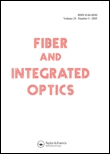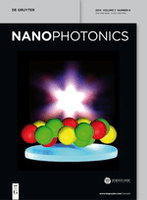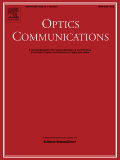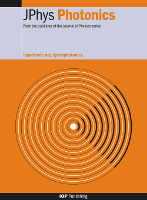
Optoelectronics Letters
metrics 2024
Fostering Innovation in Light and Matter
Introduction
Optoelectronics Letters, published by Tianjin University of Technology, is an esteemed platform for the dissemination of innovative research within the fields of atomic and molecular physics, optics, condensed matter physics, and electrical engineering. With its inaugural publication in 2007 and a convergence period extending to 2024, this journal aims to foster scholarly communication and collaboration among researchers and professionals. Although currently lacking an impact factor, it serves a vital niche in the rapidly evolving field of optoelectronics, evidenced by its categorization in the fourth quartile for various physics disciplines and the third quartile in electrical and electronic engineering. Given its ranking dynamics in Scopus, it is an emerging choice for authors seeking to convey their findings on electronic, optical, and magnetic materials. Researchers, students, and industry professionals alike can benefit from its open access options, encouraging a broad dissemination of cutting-edge knowledge that is essential in the advancement of technology and materials science.
Metrics 2024
 0.23
0.23 0.80
0.80 0.70
0.70 22
22Metrics History
Rank 2024
Scopus
IF (Web Of Science)
JCI (Web Of Science)
Quartile History
Similar Journals

Advanced Optical Materials
Pioneering Developments in Electronic and Optical MaterialsAdvanced Optical Materials, published by WILEY-V C H VERLAG GMBH, stands as a premier journal within the fields of atomic and molecular physics, as well as electronic, optical, and magnetic materials. With a substantial impact factor reflecting its significance—ranking in the Q1 category among both Atomic and Molecular Physics and Electronic, Optical and Magnetic Materials—this journal offers a vital platform for disseminating groundbreaking research. The journal's Scopus rank positions it at an impressive 14th out of 224 in its category and 25th out of 284 in materials science, illustrating its commitment to advancing knowledge and innovation. Covering a diverse range of topics and trends from 2013 to 2024, Advanced Optical Materials is essential for researchers, professionals, and students who are exploring the cutting-edge developments in optical technologies. Despite not being open access, the journal provides high-quality peer-reviewed articles that contribute substantially to the academic community, helping to shape the future of materials research.

Chinese Optics
Advancing the Frontiers of Light and Knowledge.Chinese Optics is a premier journal dedicated to advancing the field of optics, encompassing research on atomic and molecular physics. Published by the esteemed Changchun Institute of Optics Fine Mechanics & Physics in China, this journal supports the sharing of cutting-edge findings since its inception in 2010. With an ISSN of 2097-1842, it operates within a competitive landscape, currently positioned in Q3 of the category for Atomic and Molecular Physics and Optics, according to the 2023 metrics. While the journal is not open access, it offers a valuable platform for researchers, professionals, and students to explore and contribute to significant discoveries in the realm of optics and light technology. By fostering scholarly communication, Chinese Optics plays a crucial role in bridging theoretical and practical aspects, making it an indispensable resource for those passionate about the optical sciences.

FIBER AND INTEGRATED OPTICS
Fostering Breakthroughs in Optical TechnologiesFIBER AND INTEGRATED OPTICS is a prominent academic journal published by TAYLOR & FRANCIS INC, focusing on the cutting-edge domains of optical and fiber technologies. Since its inception in 1977, the journal has journeyed through expansive developments in the fields of Atomic and Molecular Physics, as well as Electronic, Optical, and Magnetic Materials, boasting a converged publication history extending to 2024. With a solid reputation reflected in its Q3 rankings in both aforementioned categories, FIBER AND INTEGRATED OPTICS serves as an essential platform for researchers, professionals, and students to disseminate and explore innovative findings and methodologies. Although currently not offering Open Access, its scholarly contributions remain invaluable, fostering a deeper understanding and advancements in fiber optic applications and integrated optical systems. Situated in the United Kingdom, the journal continues to attract a diverse global audience, solidifying its significance in contemporary scientific discourse.

OSA Continuum
Bridging Theory and Application in Optical SciencesOSA Continuum, published by the Optica Publishing Group, is a distinguished open access journal dedicated to advancing research in the realms of Atomic and Molecular Physics, Optics, and Electronic and Electrical Engineering. Since its inception in 2018, this journal has rapidly positioned itself as a significant platform for disseminating cutting-edge findings, achieving impressive Scopus rankings with a 61st percentile in Electrical and Electronic Engineering and 57th in Atomic and Molecular Physics. Based in the United States, the journal not only promotes scholarly dialogue among researchers and professionals but also plays a crucial role in bridging theoretical advances with practical applications in optical and material sciences. Its open access format ensures broader visibility and accessibility of research outputs, fostering innovation and collaboration across disciplines. With its ongoing commitment to excellence, OSA Continuum is crucial for anyone involved in these dynamic fields.

Photonics
Exploring the Frontiers of Light and TechnologyPhotonics, an esteemed journal published by MDPI, is a leading platform for researchers in the fields of atomic and molecular physics, optics, and instrumentation. Since its inception in 2014, the journal has fostered open access to cutting-edge research, facilitating knowledge dissemination in these dynamic disciplines. With its Q2 ranking in the 2023 Scopus metrics for various categories, including radiology, nuclear medicine, and imaging, Photonics represents a crucial academic resource for professionals and students seeking to advance their understanding and expertise. Located in Basel, Switzerland, the journal plays a pivotal role in bridging theoretical and practical approaches to photonic technologies. Researchers are encouraged to contribute their findings, thereby enriching the journal’s impact and relevance in the global scientific community through collaboration and innovation.

Nonlinear Optics Quantum Optics-Concepts in Modern Optics
Unraveling the Mysteries of Light through InnovationNonlinear Optics Quantum Optics-Concepts in Modern Optics is a specialized journal published by OLD CITY PUBLISHING INC, focusing on the forefront of research in nonlinear optics and quantum optics. With an ISSN of 1543-0537 and an E-ISSN of 1944-8325, this journal serves as a pivotal platform for the dissemination of innovative concepts and findings in modern optics, significant for both theoretical exploration and practical applications. Established in 2003, the journal's scope encompasses critical areas such as atomic and molecular physics, optical materials, and instrumentation, attracting submissions from a diverse range of interdisciplinary fields. While the journal currently maintains a Q4 ranking in several categories, it continues to strive for higher visibility and impact in the academic community. Researchers and students alike will find valuable insights and contributions that foster advancements in optical science and engineering. With an emphasis on rigorous peer-review, Nonlinear Optics Quantum Optics-Concepts in Modern Optics is committed to enhancing the understanding and application of nonlinear optical phenomena in various technological domains.

Nanophotonics
Shaping Tomorrow’s Technology with NanophotonicsNanophotonics, published by WALTER DE GRUYTER GMBH, is a premier open access journal dedicated to advancing the field of nanophotonics, encompassing cutting-edge research in atomic and molecular physics, optics, biotechnology, and electronic engineering. With a significant impact factor and a notable presence in the top quartile rankings (Q1) across multiple categories, including electrical and electronic engineering, this journal serves as a critical resource for researchers and professionals aiming to explore the latest developments in the manipulation of light at the nanoscale. Since its inception in 2012, Nanophotonics has been an influential platform for disseminating innovative ideas and breakthroughs, offering unrestricted access to its content, thus fostering a collaborative environment conducive to scientific discovery. Located in Berlin, Germany, and with a commitment to promoting the highest standard of scholarly excellence, Nanophotonics continues to shape the future of optical materials and technology, inviting contributions from both established experts and emerging scholars.

OPTICS COMMUNICATIONS
Exploring the Frontiers of Optical CommunicationOptics Communications, published by Elsevier, is a prestigious international journal that focuses on the dynamically evolving fields of optics and photonics. With its ISSN 0030-4018 and E-ISSN 1873-0310, this journal has made significant contributions to the fields of Atomic and Molecular Physics, Electrical and Electronic Engineering, Electronic, Optical and Magnetic Materials, and Physical and Theoretical Chemistry, consistently ranking in the Q2 quartile across these categories for 2023. The journal, based in the Netherlands, is recognized for its rigorous peer-review process and aims to publish high-quality research articles that advance knowledge and applications in optical communication technologies. Although it operates under a subscription model, the insightful research published here plays an essential role in informing the work of researchers, professionals, and students alike. With a history dating back to 1969 and spanning well into 2025, Optics Communications remains a crucial resource for cutting-edge developments in optics, catering to a global audience dedicated to innovation in this pivotal science.

JOURNAL OF MODERN OPTICS
Transforming Insights into Optical ApplicationsJOURNAL OF MODERN OPTICS, published by Taylor & Francis Ltd, stands as a prominent bi-monthly journal contributing to the fields of Atomic and Molecular Physics and Optics. With an ISSN of 0950-0340 and an E-ISSN of 1362-3044, this journal aims to disseminate high-quality research that pushes the boundaries of optical science and its applications. Since its inception in 1981, and particularly throughout its publications from 1987 to 2024, the journal has consistently published influential studies that are essential for both academic researchers and industry professionals. Ranked in the Q3 quartile for the 2023 category of Atomic and Molecular Physics and Optics, it has a Scopus ranking of #133 out of 224, indicating its steady presence and relevance in the scientific community. Although it does not offer Open Access options, readers can access its rich repository of literature that delves into innovative optical methods, technological advancements, and theoretical frameworks. The JOURNAL OF MODERN OPTICS is an indispensable resource for those seeking to advance their knowledge and research in modern optical science.

Journal of Physics-Photonics
Fostering Collaboration in the World of PhotonicsJournal of Physics-Photonics, published by IOP Publishing Ltd in the United Kingdom, is an esteemed Open Access journal that has been at the forefront of research in the field of photonics since its inception in 2018. With an impressive portfolio, the journal has achieved Q1 ranking in 2023 across multiple disciplines, including Atomic and Molecular Physics, Electrical and Electronic Engineering, and Electronic, Optical, and Magnetic Materials. This positions it among the leading journals in these areas, reflecting its significant influence and contribution to advancing knowledge and innovation. The journal aims to disseminate high-quality research findings that encompass a wide range of topics in photonics, promoting interdisciplinary approach that fosters collaboration among researchers, professionals, and students. With its commitment to open access, Journal of Physics-Photonics ensures that groundbreaking research is accessible to all, empowering a global audience to engage with and benefit from the latest advancements in photonic technologies.